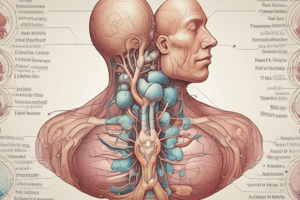Podcast
Questions and Answers
What is the characteristic feature of the zona reticularis?
What is the characteristic feature of the zona reticularis?
- It is composed of cords that branch and anastomose with each other (correct)
- It is responsible for the production of adrenaline and noradrenaline
- It is the outermost layer of the cortex
- It is made up of cells with high lipid content
What is a distinct feature of cells in the zona reticularis?
What is a distinct feature of cells in the zona reticularis?
- They are larger and more basophilic than other cells
- They are smaller and more acidophilic than other cells (correct)
- They have secretory granules
- They are similar to those of the zona fasciculata but with higher lipid content
What is a common feature of all cells in the cortex?
What is a common feature of all cells in the cortex?
- They have secretory granules
- They have abundant smooth endoplasmic reticulum (correct)
- They have high lipid content
- They are involved in the production of adrenaline and noradrenaline
What is the function of chromaffin cells in the suprarenal medulla?
What is the function of chromaffin cells in the suprarenal medulla?
What is a characteristic of mitochondria in steroid-secreting cells?
What is a characteristic of mitochondria in steroid-secreting cells?
What is the main difference between the suprarenal cortex and medulla?
What is the main difference between the suprarenal cortex and medulla?
What is a characteristic of cells in the suprarenal medulla?
What is a characteristic of cells in the suprarenal medulla?
What is the function of ganglion cells in the suprarenal medulla?
What is the function of ganglion cells in the suprarenal medulla?
What is the difference between chromaffin cells and ganglion cells in the suprarenal medulla?
What is the difference between chromaffin cells and ganglion cells in the suprarenal medulla?
What is a characteristic of lipid droplets in steroid-secreting cells?
What is a characteristic of lipid droplets in steroid-secreting cells?
Study Notes
Thyroid Gland
- Located on either side of the trachea, below the larynx
- Bi-lobed gland connected by an isthmus in front of the trachea
- Unique in storing large quantities of its secretion extracellularly as colloid
- Structure consists of:
- Stroma: capsule, trabeculae, and reticular fibers
- Parenchyma: thyroid follicles and blood vessels
- Thyroid follicle:
- Structural unit of the thyroid gland
- Spherical in shape
- Lined by follicular cells and parafollicular cells (C-cells)
- Contains colloid (thyroglobulin), a storage form of thyroid hormones
- Follicular cells:
- Cuboidal cells resting on a basement membrane
- Vary in shape depending on activity level
- Secrete triodothyronine (T3) and tetraiodothyronine (T4 or thyroxine)
- Influenced by thyroid-stimulating hormone (TSH) produced by the pituitary gland
- Parafollicular cells (C-cells):
- Few in number, larger in size with pale cytoplasm
- Rest on the basement membrane but don't reach the lumen
- Secrete thyrocalcitonin, which lowers blood calcium levels by suppressing bone resorption
Parathyroid Glands
- Four glands located on the posterior aspect of the thyroid
- Structure consists of:
- Stroma: capsule, trabeculae, and reticular fibers
- Parenchyma: cords of cells separated by blood vessels
- Two types of cells:
- Chief cells (Principal):
- Small, rounded, and numerous
- Vesicular nuclei
- Cytoplasm accumulates glycogen
- Secrete parathyroid hormone (parathormone) that increases serum calcium level
- Oxyphil cells (eosinophilic):
- Larger than chief cells
- Zona reticularis: innermost layer of the cortex with a reticulum-like structure
- Chief cells (Principal):
Suprarenal Gland
- Cortex:
- Cords of cells separated by blood vessels
- Cells have ultrastructure features of steroid-secreting cells:
- Abundant smooth endoplasmic reticulum
- Mitochondria with tubular cristae
- Lipid droplets
- No secretory granules
- Medulla:
- Different from the cortex both functionally and embryologically
- Cords of cells separated by wide sinusoids
- Cells are polyhedral with basophilic cytoplasm
- Two types of cells:
- Chromaffin cells:
- Secrete adrenaline and noradrenaline mainly at times of stress
- Effects similar to sympathetic stimulation
- Ganglion cells
- Chromaffin cells:
Studying That Suits You
Use AI to generate personalized quizzes and flashcards to suit your learning preferences.
Description
Test your knowledge of the endocrine system, focusing on the thyroid gland and suprarenal gland. This quiz covers the structure and function of these essential glands, including their unique characteristics and secretions. Learn about the thyroid gland's storage of colloid and its role in the endocrine system.




